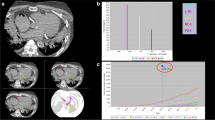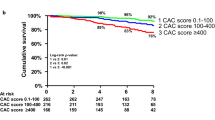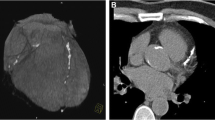Abstract
This study sought to explore the feasibility and utility of post-mortem coronary artery calcium (CAC) scoring in identifying patients with ischemic heart disease as cause of sudden death. 100 deceased patients aged 18–50 years underwent post-mortem examination in the setting of sudden death. At post-mortem, fifty cases were determined to have ischemic heart disease, and fifty had death attributed to trauma or unascertained causes. The CAC score was calculated in a blinded manner from post-mortem CTs performed on all cases. CAC scores were assessable in 97 non-decomposed cases (feasibility 97%). The median CAC score was 88 Agatston units [IQR 0–286] in patients deceased from ischemic heart disease vs 0 [IQR 0–0] in patients deceased from other causes (p < 0.0001). Presence of any coronary calcification differed significantly between ischemic heart disease and non-ischemic groups (adjusted odds ratio 10.7, 95% CI 3.2—35.5). All cases with a CAC score > 100 (n = 22) had ischemic heart disease as the cause of death. Fifteen cases had a CAC score of zero but severe coronary disease at post-mortem examination. Post-mortem CAC scoring is highly feasible. An elevated CAC score in cases 18–50 years old with sudden death predicts ischemic heart disease at post-mortem examination. However, a CAC score of zero does not exclude significant coronary artery disease. Post-mortem CAC score may be considered as a further assessment tool to help predict likely cause of death when there is an objection to or unavailability of post-mortem examination.



Similar content being viewed by others
Data availability
Relevant data and de-identified source material can be provided at request.
References
Basso C, et al. Guidelines for autopsy investigation of sudden cardiac death: 2017 update from the Association for European Cardiovascular Pathology. Virchows Arch. 2017;471:691–705.
Bedford PJ. Routine CT scan combined with preliminary examination as a new method in determining the need for autopsy. Forensic Sci Med Pathol. 2012;8:390–4.
O’Grady G. Death of the teaching autopsy. BMJ. 2003;327:802–3.
Shojania KG, Burton EC. The vanishing nonforensic autopsy. N Engl J Med. 2008;358:873–5.
Turnbull A, Osborn M, Nicholas N. Hospital autopsy: Endangered or extinct? J ClinPathol. 2015;68:601–4.
Roberts IS, et al. Post-mortem imaging as an alternative to autopsy in the diagnosis of adult deaths: a validation study. Lancet. 2012;379:136–42.
Michaud K, et al. Postmortem imaging of sudden cardiac death. Int J Legal Med. 2014;128:127–37.
O’Donnell C, et al. Current status of routine post-mortem CT in Melbourne. Australia Forensic Sci Med Pathol. 2007;3:226–32.
Blaha MJ, et al. Improving the CAC score by addition of regional measures of calcium distribution: Multi-ethnic study of atherosclerosis. JACC Cardiovasc Imaging. 2016a;9:1407–16.
Blaha MJ, et al. Rationale and design of the coronary artery calcium consortium: A multicenter cohort study. J CardiovascComputTomogr. 2017a;11:54–61.
Nasir K, et al. Implications of coronary artery calcium testing among statin candidates according to American College of Cardiology/American Heart Association cholesterol management guidelines: MESA (Multi-Ethnic Study of Atherosclerosis). J Am CollCardiol. 2015;66:1657–68.
Nakanishi R, et al. All-cause mortality by age and gender based on coronary artery calcium scores. Eur Heart J Cardiovasc Imaging. 2016;17:1305–14.
Al Rifai M, Cainzos-Achirica M, Blaha MJ. Establishing the warranty of a coronary artery calcium score of zero. Atherosclerosis. 2015;238:1–3.
Kianoush S, et al. Coronary artery calcium scoring in current clinical practice: How to define its value? Curr Treat Options Cardiovasc Med. 2017;19:85.
Australian Bureau of Statistics. Australian Demographic Statistics, end-quarter June 2018. 2018. Commonwealth of Australia.
Victorian Institute of Forensic Medicine. VIFM Annual Report 2017–18. 2018. Melbourne: Australia. pp. 27.
Raju H, et al. Insights into sudden cardiac death: exploring the potential relevance of non-diagnostic autopsy findings. Eur Heart J. 2019;40:831–8.
Sutherland T, O’Donnell C. The artefacts of death: CT post-mortem findings. J Med Imaging RadiatOncol. 2018;62:203–10.
Sundaram B, et al. Anatomy and terminology for the interpretation and reporting of cardiac MDCT: part 1. Structured report, coronary calcium screening, and coronary artery anatomy. AJR Am J Roentgenol. 2009;192:574–83.
Blaha MJ, et al. Coronary artery calcium scoring: Is it time for a change in methodology? JACC Cardiovasc Imaging. 2017b;10:923–37.
Hamilton-Craig CR, Liew G, Chan J, Chow C, Jelinek M, van Pelt N, et al. Coronary artery calcium scoring - Position statement. 2017. Cardiac Society of Australia New Zealand. pp. 1–21.
Neves PO, Andrade J, MoncaoH. Coronary artery calcium score: current status. Radiol Bras. 2017;50:182–9.
Gascho D, Thali MJ, Niemann T. Post-mortem computed tomography: Technical principles and recommended parameter settings for high-resolution imaging. Med Sci Law. 2018;58:70–82.
Blaha MJ, et al. Role of coronary artery calcium score of zero and other negative risk markers for cardiovascular disease: The multi-ethnic study of atherosclerosis (MESA). Circulation. 2016b;133:849–58.
Shareghi S, et al. Prognostic significance of zero coronary calcium scores on cardiac computed tomography. J CardiovascComputTomogr. 2007;1:155–9.
Saad M, et al. Coronary artery calcium scoring in young adults: Evidence and challenges. CurrCardiol Rep. 2018;20:10.
Bittencourt MS, et al. Implications of coronary artery calcium testing on risk stratification for lipid-lowering therapy according to the 2016 European Society of Cardiology recommendations: The MESA study. Eur J PrevCardiol. 2018;25:1887–98.
Line B. Why you don’t need a heart scan or a coronary artery calcium score test. 2014. https://bottomlineinc.com/health/cardiovascular-disease/why-you-dont-need-a-heart-scan-or-a-coronary-artery-calcium-score-test. Accessed 25 Jan 2019.
Bhulani N, et al. Coronary calcium scoring: are the results comparable to computed tomography coronary angiography for screening coronary artery disease in a South Asian population? BMC Res Notes. 2013;6:279.
Mittal TK, et al. Prevalence of obstructive coronary artery disease and prognosis in patients with stable symptoms and a zero-coronary calcium score. Eur Heart J Cardiovasc Imaging. 2017;18:922–9.
Correia LCL, et al. Zero calcium score as a filter for further testing in patients admitted to the coronary care unit with chest pain. Arq Bras Cardiol. 2017;109:97–102.
Sarwar A, et al. Diagnostic and prognostic value of absence of coronary artery calcification. JACC Cardiovasc Imaging. 2009;2:675–88.
Femia G, et al. Post-mortem imaging adjudicated sudden death: causes and controversies. Heart Lung Circ. 2019;28:15–21.
Gascho D, et al. Synergy of CT and MRI in detecting trajectories of lodged bullets in decedents and potential hazards concerning the heating and movement of bullets during MRI. Forensic Sci Med Pathol. 2020;16:20–31.
Vester MEM, et al. Postmortem computed tomography in firearm homicides: A retrospective case series. J Forensic Sci. 2020;65:1568–73.
Higgins S, et al. The effect of post-mortem computed tomography angiography (PMCTA) using water-soluble, iodine-based radiographic contrast on histological analysis of the liver, kidneys and left ventricle of the heart. Forensic Sci Med Pathol. 2017;13:317–27.
Ross SG, et al. Sudden death after chest pain: feasibility of virtual autopsy with postmortem CT angiography and biopsy. Radiology. 2012;264:250–9.
Takahashi Y, et al. Use of postmortem coronary computed tomography angiography with water-insoluble contrast medium to detect stenosis of the left anterior descending artery in a case of sudden death. Leg Med (Tokyo). 2016;19:47–51.
Takei H, et al. Usefulness of coronary postmortem computed tomography angiography to detect lesions in the coronary artery and myocardium in cases of sudden death. Leg Med (Tokyo). 2018;30:46–51.
Michaud K, et al. Evaluation of postmortem MDCT and MDCT-angiography for the investigation of sudden cardiac death related to atherosclerotic coronary artery disease. Int J Cardiovasc Imaging. 2012;28:1807–22.
Polacco M, et al. Visualization of myocardial infarction by post-mortem single-organ coronary computed tomography: a feasibility study. Int J Legal Med. 2015;129:517–24.
Rutty GN, et al. Diagnostic accuracy of post-mortem CT with targeted coronary angiography versus autopsy for coroner-requested post-mortem investigations: a prospective, masked, comparison study. Lancet. 2017;390:145–54.
Burke AP, et al. Coronary calcification: insights from sudden coronary death victims. Z Kardiol. 2000;89(Suppl 2):49–53.
Gheorghe AG, et al. Coronary artery CT calcium score assessed by direct calcium quantification using atomic absorption spectroscopy and compared to macroscopic and histological assessments. Int J Legal Med. 2019;133:1485–96.
Funding
This project was not directly funded. EDP is supported by a NHMRC/NHF co-funded Postgraduate Scholarship (APP 1168218), RACP JJ Billings Scholarship and PSA Cardiovascular Scholarship. ALG is supported by a NHF Future Leader Fellowship. DS is supported by a NHF Future Leader Fellowship and Viertel Foundation Grant. CS is supported by a NHMRC Australia Practitioner Fellowship. The EndUCD registry is supported by the Ross Dennerstein Foundation.
Author information
Authors and Affiliations
Contributions
All authors contributed to the article design, analysis and write-up. All authors have confirmed that they are happy for publication of the article.
Corresponding author
Ethics declarations
Conflicts of interest
No conflict of interest has been identified.
Ethical approval
This study complies with the ethical principles of the Declaration of Helsinki. Ethical approval was granted by the institutional ethics committee (approval number 03/2018).
Informed consent
All authors have confirmed that they are happy for publication of the article. The Victorian Institute of Forensic Medicine has provided written confirmation of permission to publish the material.
Additional information
Publisher’s Note
Springer Nature remains neutral with regard to jurisdictional claims in published maps and institutional affiliations.
Rights and permissions
About this article
Cite this article
Paratz, E.D., Costello, B., Rowsell, L. et al. Can post-mortem coronary artery calcium scores aid diagnosis in young sudden death?. Forensic Sci Med Pathol 17, 27–35 (2021). https://doi.org/10.1007/s12024-020-00335-z
Accepted:
Published:
Issue Date:
DOI: https://doi.org/10.1007/s12024-020-00335-z




